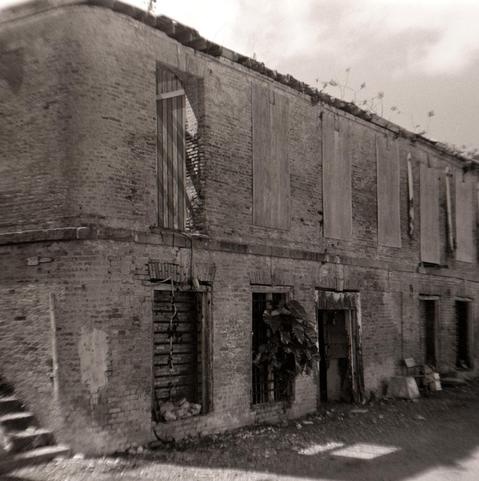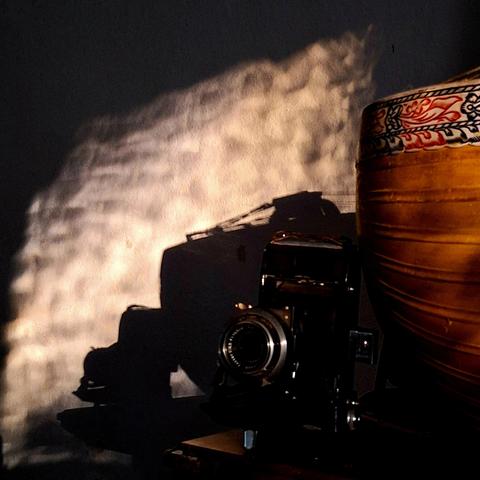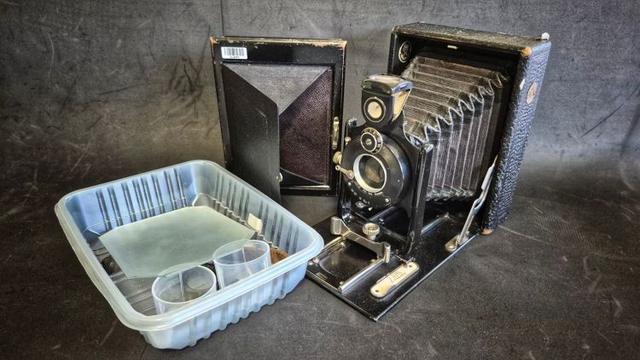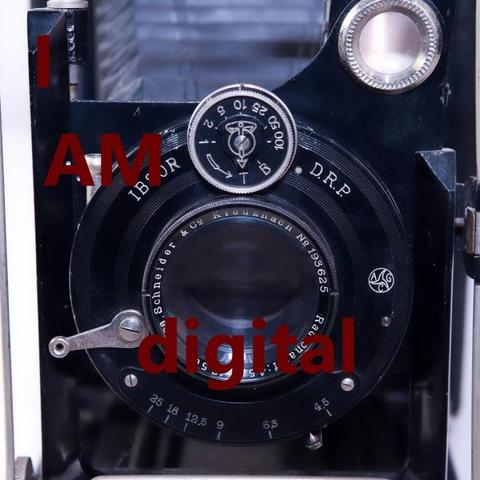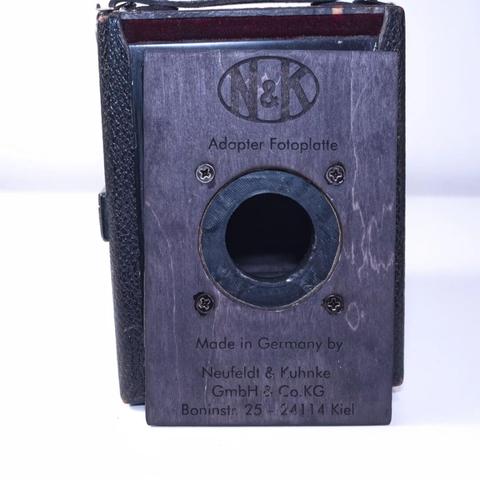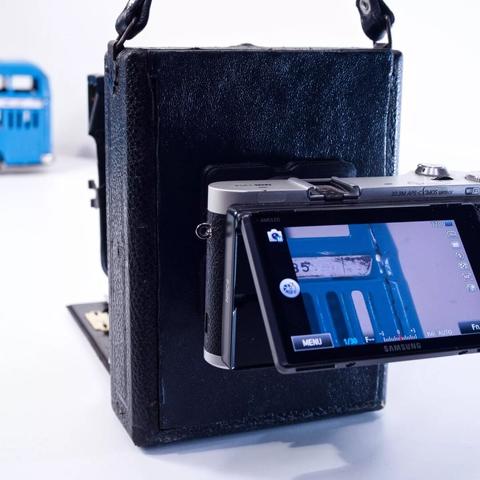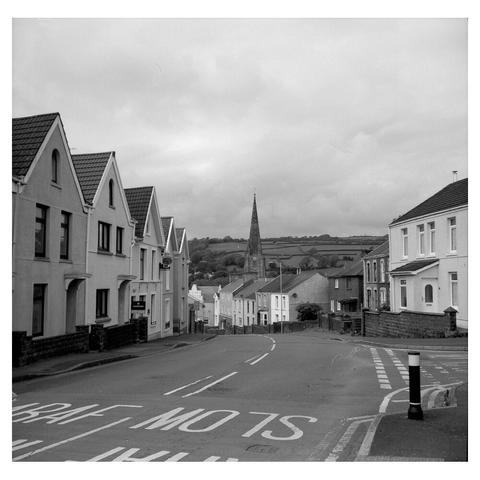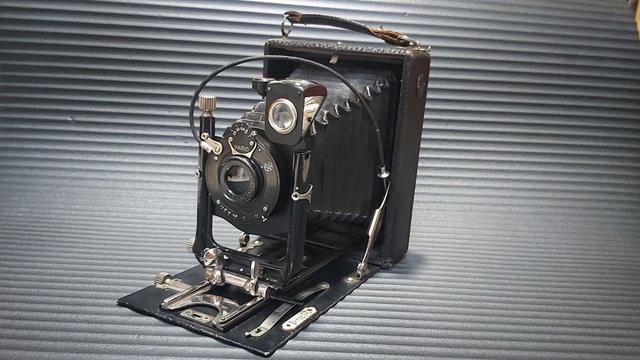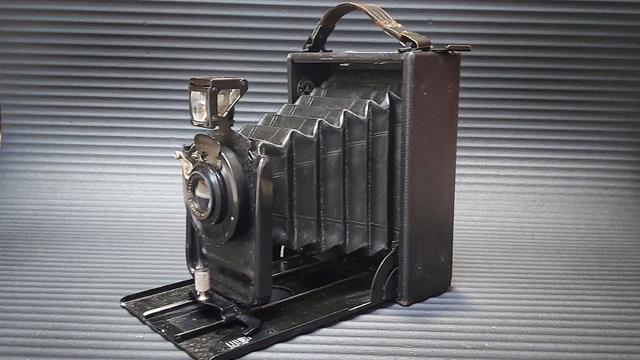📷️ Agfa Isolette II
🎞️ Illford HP5
🧪 Kodak HC110
📍St. Croix, USVI
#fensterfreitag #filmphotography #blackandwhite #foldingcamera
#FoldingCamera
Nature morte : appareil photo à soufflet et Vina éclairés par un reflet de soleil a travers une vitre martelée.
#WavyWednesday made it to my timeline today, and an image I made over the summer came to mind.
The layered pattern of the walls of a 3d printed concrete structure caught my eye so I got close using a little Agfa Isolette II folding camera and Illford HP5.
A beautiful clear day allowed me to get out and try and adjust the rangefinder of this camera's rangefinder.
The top cover was simple to remove exposing the rangefinder adjustment screw.
Turning the focus to infinity and pointing the range finder at a distant object I was able to turn the adjustment screw until the images aligned.
Now to put another test roll through it to see if the focus matches.
An update on the smelly old ICA Sirene 135. A contender for the #ShittyCameraChallenge?
It’s been months since I posted about the ICA Sirene 135, literally. The first post about this smelly old camera was in June 2024, then I left it outside for a few weeks before putting it into a box with some mothballs. It remained there for the five weeks we were on holiday and by then the smell of mothballs was so overpowering it was kept outside a little longer to ‘freshen up’. Then, in October, I gave it a good sniff and the mothballs smell had gone but the original tobacco smell still lingered. I brought it into the office, as the weather outside was getting a little damp, and it’s been airing there ever since.
So now it’s November and in the next few days the latest Shitty Camera Challenge will commence. I’ve been taking part in the #ShittyCameraChallenge for a few years now (and was honoured to be ‘crowned’ Shitty Camera Challenge Champion for the #1990sCameraChallenge event a couple of years ago, though I’ll never let anyone forget it) and although I normally submit a lot of digital entries, this time I’ve decided to concentrate on film. Giving the smelly old Sirene 135 a sniff, I reckon it’s time to put it all back together and, who knows, actually use it in the Challenge.
As a reminder, the ICA Sirene 135 was from the Kamerastore’s ‘Not Passed’ category. It had ‘flaws that will affect typical use’, in this case, ‘haze and fungus inside [the lens]. The viewfinder and ground glass are hazy. The shutter is sticky [and the] body has signs of corrosion and mold (sic).’ Most of all, ‘it smells’. And it certainly did, and to my mind the description on the Kamerastore website actually understated the smell. It was an all-encompassing deep lingering odour that just clung to the camera and wouldn’t let go. I actually thought it was years of nicotine staining from being in a smoky environment, but who really knows. Anyhow, the Sirene 135 got a good deep clean, inside and out, including the lenses and the ground glass, and it cleaned up beautifully. Apart from the smell. Thus began the weeks, no months, of airing
So now the smelly old Sirene 135 is ready to be put back together. Before I started I gave the camera a good clean inside and out, including a jet of air around the bellows. The first step was to reinstall the lenses, which went fine, and then reassemble the viewing screen. The ground glass was now lovely and clean, all the old debris had been removed and it just needed a quick wipe with a soft cloth. After about twenty minutes the Sirene was back together and the shutter firing nicely. I took it outside and double checked the focusing and discovered that to get infinity focus the camera needed to be on the ‘2’ metre mark. I’m not sure whether that was because I’ve not seated the lenses properly or what, but it seems to work otherwise.
It certainly looks like the ICA Sirene 135 will be used in the Shitty Camera Challenge this time around. Checking the body I need a couple of tripod adapters as the thread for the tripod is 1920s 3/8 inch standard instead of today’s 1/4 inch, but aside from that the ICA Sirene 135 is ready for action. It still smells, though.
If you are on Mastodon, you can now follow this blog directly. Just go to Mastodon and follow my WordPress account at @keithdevereux.wordpress.com. All new posts will be automatically updated to your timeline on Mastodon.
#1920s #AntiqueCamera #Experimental #Film #FoldingCamera #ICA #OldCamera #Retro #Shittycamerachallenge #Sirene135 #Vintage #VintageCamera
A few shots from the initial test roll.
Good news is the camera seems to be functional and the shutter speeds seem correct. Bad news is the range finder does seem to be off slightly.
I think a more precise test is in order, and then maybe look into the possibilities of calibrating the range finder on this thing.
📷 Mamiya 6 K
🎞️ Kentmere 400
Put a roll through an old (new to me) Mamiya 6 folding rangefinder camera. It shoots 120 film at both 6x6 and 6x4.5, and has an interesting focus mechanism that moves the film plane rather than the lens.
Aside from some cosmetic dings, it seems to be in pretty good shape. Though the rangefinder seems like it may be out of alignment.
Excited to get this roll processed and see how it's shooting.
Inspired by Hasselblad, who created a Digital Back to bring old analog cameras into the 21st century, we wanted something similar for our vintage cameras. After six months of intense development, we've perfected the adapter. We currently offer this adapter for Micro Four Thirds, Samsung NX, Sony E-Mount (NEX), and Canon EF mounts. More mounts will follow, but we insist on testing each adapter thoroughly by purchasing a camera from the corresponding series and developing the adapter directly on that camera.
This product represents true circular economy and is entirely made in Germany. The photo plate is milled, laser-cut, stained, and finished with real leather here on site. The adapter itself comes from our 3D printer.
#digitalcamera #lensmount #camera #upcycling #foldingcamera #adapter #lens #innovation #trademarkprotection #developmenttime #circulareconomy #photography #bellowscamera #photoplate #digital #imagedigitization
#digitizing #digitization
#digitalkamera #objektivanschluss #fotokamera #upcycling #laufbodenkamera #adapter #objektiv #weiterentwicklung #mut #markenschutz #entwicklungszeit #kreislaufwirtschaft #fotografie #balgenkamera #fotoplatte #digital #digitalisierung
I don’t really need another folder, I really don’t, but the ICA Sirene 135 was so cheap that I thought I could take the ground glass from this one and fit it into the back of the Stölma II folding camera so I could use that with the KW Patent Etui. Basically this was a back for the Patent Etui. Of course it was from the Kamerastore’s ‘Not Passed’ category, it has ‘flaws that will affect typical use’, in this case, it smells. And it certainly does. I’m not sure what the smell actually is, it’s certainly not your typical musty smell but an all encompassing deep lingering smell. I actually think it’s years of nicotine staining from smoking, it has that musky old tobacco smell that you just can’t get rid of.
Like most of the folders I’ve been getting, apart from the smell, the Sirene 135 ‘has haze and fungus inside [the lens]. The viewfinder and ground glass are hazy. The shutter is sticky [and the] body has signs of corrosion and mold (sic).’ It therefore needs a good deep clean, inside and out, including the lenses, especially the front one which had white spots on. The first thing I did was to give the body a good wipe with a damp cloth, then I removed the camera back and took out the ground glass, which also got a good scrub, and cleaned up beautifully.
I turned my attention to the lens and shutter assembly. With a pair of fine-nosed pliers I loosened the front and rear lenses. These were cleaned with alcohol and wiped down with a microfibre cloth. The haze and marks on the lenses were completely removed and both are now clear and clean. The viewfinder was also dirty, but a good rub with an alcohol soaked cotton bud cleaned that up nicely. Finally, I cleaned as best I could the bellows, rail and inside the camera.
According to the Kamerastore description the shutter was ‘sticky’. Admittedly there was some debris on the shutter, which I cleaned off, yet when I fired the shutter it was fine at all speeds with no signs of stickiness. So, apart from the smell the Sirene 135 is now as clean as possible and ready to be assembled. However, I’ve put that off for the moment and am leaving the camera in the open air to ventilate and, hopefully, get rid of most of the smell.
Apart from the smell, which is an issue that dominates this post (much like the smell) now that it’s been cleaned the ICA Sirene 135 is in pretty good condition. So let’s take a look at what I’ve been able to find out about the history of this camera. Between 1909 and 1912 five camera manufacturers (Hüttig AG, Kamerawerk Dr. Krügener. Wünsche AG, Carl Zeiss Palmos AG, and the Swiss company Zulauf), united to become Internationale Camera A.G. (ICA). Together they produced a range of roll film and plate cameras, including the Sirene 135, which was originally made by Wünsche, from 1914 to 1926. My particular model was sold by Foto Kompaniet in Gelfe, which I believe is Gelve in Sweden, according to the little stamp on the side of the camera. The likelihood is, therefore, that the ICA Sirene 135 was imported to Sweden from Germany and sold on the Swedish market.
The Sirene 135 is an all wooden camera, apart from the front door/rails and lens assembly, with a two-element ‘Extra-Rapid-Aplanat Helios’ lens, a focal length of 13cm and a maximum aperture of f8. The Sirene 135 has aperture settings of f8, f12.5, f18, f25 and f36 and shutter speeds of Z (Zeit, or Time), B (Bulb), 1/25s, 1/50s, and 1/100s. At either end of the shutter speed dial are two five-pointed stars, which was the company logo representing the five companies that united to form ICA . From 1909, ICA used a letter followed by a five digit number for its serial numbers, and since the serial number of the Sirene 135 is H10748, this suggests that the camera was produced in 1922/23.
At the moment the camera is in bits in a box while I try to find some way to get rid of the smell. I’m leaving it outside in the fresh air and all being well the smell will dissipate. There are products available that I can spray over the smelly old camera to neutralise the odour but I’m a little nervous about spraying stuff on the camera and causing even more damage. Oh, and the reason for getting it? To use the ground glass screen in the Stölma II camera? Well that didn’t work, the glass was too wide to fit comfortably into the Stölma II film back. I could trim it down but it’s so clean now that I’m going to refit it back into the ICA Sirene 135. Besides, I have some Leelux 400 diffusion filter now that should work admirably.
ADDENDUM: After a few weeks in the sun and fresh air the smell is almost completely gone. There’s still a slight odour remaining but in comparison to what was there originally it’s almost smell free. Soon it’ll be time to reassemble the camera and take a couple of test shots, but first I’m going to give it a weekend in a both with some mothballs and then a few more days in the open air to get rid of that smell.
If you are on Mastodon, you can now follow this blog directly. Just go to Mastodon and follow the ‘Snapshot’ WordPress account at @keithdevereux.wordpress.com. All new posts will be automatically updated to your timeline.
#1920s #AntiqueCamera #Experimental #Film #FoldingCamera #ICA #OldCamera #Retro #Shittycamerachallenge #Sirene135 #Vintage #VintageCamera
Zeiss Ikon Nettar
Novar Anastigmat 75mm f/4.5
Kodak TMAX 100
#photography #FilmPhotography #ShootItWithFilm #ShootFilm #Kodak #MadeWithKodak #BlackAndWhite #BnW, #monochrome #Kidwelly #Cydweli #Cymru #Wales, #FilmIsNotDead #MediumFormat #120 #Zeiss #ZeissIkonNettar #FoldingCamera
We went to an antique store in Lawrence, MA today. I was looking for camera gear and not expecting to find anything.
I was right that there wasn’t much to see, but I did see one that has me super intrigued.
$79 seems way too much for this, but I am going to spend some time on the YouTube doing some research and maybe I might go back again. Folding cameras from pre-war are sort of what I was thinking of for my first step into the medium format world.
We’ll see.
https://robertjames1971.blog/2024/06/29/antiques/
#antique #antiqueStore #antiquing #camera #foldingCamera #iphoneography #mediumFormat #photography
I made a diffusion gel back to use my 1920s Frankencamera with a cheap noughties Genius digicam. Look at the difference between a cheap diffusion film and Leelux 400.
#FoldingCamera, #VintageCamera, #Experimental, #Retro, #Vintage, #Digital, #1920s, #Genius, #Digicam, #Frankencamera, #ShittyCameraChallenge,
It's here! My Leelux 400 diffusion film has arrived. Took a while to hunt it down and the delivery charge was criminal. But I hope I’ll have enough to last forever now (two rolls, 50x60cm each).
#FoldingCamera, #VintageCamera, #Experimental, #Retro, #Vintage, #Digital, #1920s, #ShittyCameraChallenge,
After completing the digital Frankencamera I was writing a rough blog post to summarise my experience and went back to look at the first images produced with the Genius 8MP digicam. It wasn’t that long ago but I was blown away by the digital aerochromes and trichromes that the Genius produced. So I thought, why not see what the digital Frankencamera can do?
I mounted the Genius digicam in its cone to the back of the Frankencamera and wedged it in place so it would not move. I then set the shutter to ‘T’ and rhe aperture to its widest. I also set the Genius to a 10-second time so that I could hold a filter over the lens. I set the digicam to black and white then took photographs with red, green, blue and infrared filters from which I made a trichrome and a digital aerochrome.
What was immediately apparent is that I really need a decent diffusion gel, so will be looking around for a Leelux 400 diffusion filter. With each image there was a clearly visible hot spot and this drastically affected the exposure of each filtered image, especially the infrared image. But at least I have shown that I can produce a trichrome with the digital Frankencamera.
If you are on Mastodon, you can now follow this blog directly. Just go to Mastodon and follow the ‘Snapshot’ WordPress account at @keithdevereux.wordpress.com. All new posts will be automatically updated to your timeline on Mastodon.
#1920s #Aerochrome #Digital #Experimental #FoldingCamera #Retro #Trichrome #Vintage #VintageCamera
A while ago I made myself a Frankencamera from an old 1920s 6×9 folding camera with a 1980s Polaroid back attached. Into this I could fit one piece of Instax Wide film and, after a little messing around, produce a single instant print. Mind you, I always found this process limiting. I couldn’t really travel very far, it was time-consuming to set up and, at the end of the day, most of the exposures were failures.
Since then my technique has come a long way. Thanks to the Frugal Film Project I’ve moved on to (far too many) folding cameras and have a nice collection of plate holders into which I can load Instax Wide films. So the Frankencamera was relegated to a box and has remained untouched for several months. And then I came across the profile of @hackaninstant on Instagram, or rather the algorithm thought I might be interested in their profile — and Instagram was right.
After modifying instant cameras to take 120 roll film, @hackaninstant has started experimenting with attaching digital cameras and smartphones to take images with Polaroid cameras. This was perfect timing, since I have been looking for a ground glass viewing screen for my KW Patent Etui and when I contacted @hackaninstant for some advice on the screen he recommended a Leelux 400 diffusion filter. Sadly I’ve not been able to find the Lee diffusion filter just yet but I did manage to find a generic diffusion filter from a local photographic supplier.
Using rigid plastic from a folder I created a frame between which I mounted a piece of diffusion gel (89×135mm). This fit perfectly in the back of the Polaroid back of the Frankencamera. I checked that the mask was working and the distance from the film back to the minimum distance that I could achieve focus with the Genius digicam (13cm).
Using 5mm black foam board I constructed a cone that fit snugly over the diffusion filter in the back of the Polaroid back. To this I securely attached the Genius digicam and I was ready to turn the Frankencamera into a ‘digital camera’.
After a couple of tests I took the combination across the road to photograph my favourite tree and well. I mounted the camera onto a mobile tripod and held the cone against the Polaroid back of the Frankencamera. It wasn’t the best arrangement, but at the moment I can’t figure out how to remove the door of the Polaroid back. I took several images in portrait and landscape orientation for comparison.
On the whole the images came out quite well, certainly better than I expected. However, there was a clear hot spot in the middle of the diffusion filter and this naturally affected the exposure of the digicam resulting in a heavy vignette. I think this is because of the quality of the diffusion filter and I hope that when I can get hold of a Leelux 400 diffusion filter the results will be better. A promising start, though.
Addendum: After a few weeks I managed to get my hands on some Leelux 400 diffusion filter, a product recommended by @hackaninstant on Instagram. Comparing the Leelux with the original diffusion filter you can instantly see the difference, the Leelux 400 is so much thicker.
I cut a piece of Leelux 400 to fit in the rear of the Frankencamera and headed across the road for a comparison test. With the same setup as before I took two photographs, one with the cheap diffusion filter and one with the Leelux 400. Even on the display screen of the Genius digicam you could immediately see difference between the two materials. With the original diffusion gel there is a large ‘hot spot’ in the centre of the frame which when the digicam sets exposure result in a heavy vignette. With the Leelux 400 the image is distributed across the diffusion filter. There’s a little bit of fall off at the edges of the frame, but this was negligible. On the whole, a successful experiment and now I have enough Leelux 400 for many more attempts. I also have a folding camera with a missing ground glass screen, and I’m going to see how Leelux 400 works with that.
If you are on Mastodon, you can now follow this blog directly. Just go to Mastodon and follow the ‘Snapshot’ WordPress account at @keithdevereux.wordpress.com. All new posts will be automatically updated to your timeline on Mastodon.
https://keithdevereux.wordpress.com/2024/05/24/the-day-the-frankencamera-went-digital/
#1920s #Digital #Experimental #FoldingCamera #Retro #Vintage #VintageCamera
Following my failure in the search for a rear viewing screen suitable for use with the KW Patent Etui with the Ernemann Heag, it was back to the drawing board. Mind you, it wasn’t long before another folding camera turned up on the Kamerastore website, and this time I thought I might be lucky.
The Stölma II folding camera was made in the 1920s and sold by the Swedish importer Stölma. From what I can gather, they were either German-made cameras imported by Stölma and rebadged under the company name or were made in Sweden as a collaboration between Stölten, a subsidiary of Stölma, and another Swedish company, Simmonsen. In this case, I reckon that this is the German-made rebadged by Stölma option, as the shutter is a Gauthier AGC (Alfred Gauthier, Calmbach) Vario shutter made between 1910 and the 1920s, and the lens is a Laack Extra Rapid Aplanat f7.7 lens made by Julius Laack of Brandenburg, Germany.
The quality of this camera is actually really nice. It’s quite heavy, more like the generic folding camera than the Ernemann Heag all wooden camera, and the shutter still has the original cable release attached, in really good condition. There’s also a lovely red bubble level next to the external viewfinder (which was in really hazy condition before I cleaned it), still with the fluid and bubble inside. But what really attracted me to this camera on the Kamerastore website was the rear view of the camera looking down the bellows towards the lens: the rails to hold the viewing back were metal.
Described as, ‘in generally poor condition with fungus and haze in the lenses and holes in the bellows. The shutter speeds were not tested’, the Stölma II was in the ‘Not Passed’ category on the Kamerastore website. That didn’t really bother me as I was more interested in the viewing back to use with the Patent Etui, so placed my order and a few days later the package had arrived.
Admittedly it was in pretty rough condition, a little grubby and with peeling leatherette. But both of these were easy fixes. I opened the camera and pulled out the bellows and was pleasantly surprised to find them in remarkably good condition. There certainly weren’t the holes that I had come to expect. Indeed, from a quick glance they looked quite sound, though later my little light would show a few tiny pinholes, which I will fix with a little liquid electrical tape.
Th shutter speeds were 1/25s, 1/50, 1/100s, B and T, and although these were untested a quick run through the dial showed that the shutter was working nicely and the shutter and aperture iris were clean and functioning properly. The aperture range was quite wide, from f7.7 to f44. I turned the camera over and pulled off the back, which came off quite smoothly. I turned it over to check out the ground glass, and … there was no ground glass. Nooo!
I could not believe it. After searching high and low for a ground glass screen I had come to the decision that getting a cheap folding camera and using the back from flat in the Patent Etui would be more economical than finding just a viewing screen or getting a custom made piece of ground glass. But my first attempt with the Ernemann Heag was frustrated by it all being made of wood (though admittedly the Ernemann is beautifully constructed) and now this second try with the Stölma II folding camera was stymied by the lack of ground glass. What was I to do?
In the meantime I cleaned and dusted the exterior and the bellows of the camera, removed the lenses and cleaned both sides. I also cleaned the viewfinder, which came out much better but was not as clear as I would have liked.
A while ago I was looking for a diffusion filter that I could use with my old Frankencamera to make a ‘ground glass’ for some Through The Viewfinder type photography. A really helpful user on Instagram, @hackaninstant, suggested a Leelux 400 diffusion gel, but I just could not find a supplier for this material in Portugal. Then by chance I came across a cheap diffusion filter from my local photography supplier. It’s not Leelux but it works.
I cut a piece if diffusion gel to the same size as the ground glass that this camera requires (83×115mm). To maintain rigidity I attached the gel to a thin piece of wood either side then slid the gel into the holders and reassembled the back. I was concerned that the back wouldn’t fit smoothly into the back of the camera but intact it was fine. Looking through the film back the image was bright and clear and even on a dull day it came out well.
The last step was to see if the camera actually worked. My existing film holders fitted nicely in the back of the Stölma II so I loaded up two Instax Wide films and headed out. It was a cloudy day and I did not expect that I would need the neutral density filters but brought them along anyway. As it turned out they were not required. I set the shutter speed of the Stölma II to 1/100s and took a meter reading with the Camera Meter app. The recommended exposure at 1/100s was f32 so I took one exposure at f32 and a second exposure at f44.
After developing the films I was delighted that they both came out, though my framing was a little off, to say the least. Both exposures came out nicely, although the exposure at f31 was a little underexposed. The exposure at f44 came out really well, with nice detail in the grey cloudy sky. I think this was in fact a little underexposed, but I’m still really happy with the results. Indeed, although my portable LED light showed some pinholes there weren’t really any light leaks visible on the images. I’m still going to try to fill the holes with the liquid electrical tape, though.
If you are on Mastodon, you can now follow this blog directly. Just go to Mastodon and follow the ‘Snapshot’ WordPress account at @keithdevereux.wordpress.com. All new posts will be automatically updated to your timeline on Mastodon.
#1920s #AntiqueCamera #Experimental #Film #FoldingCamera #OldCamera #Retro #Shittycamerachallenge #StolmaKamera #Vintage #VintageCamera
I received a new (to me) folding camera recently, the KW (Kamera Werkstätten) Patent Etui. It’s a fabulous little folding camera and is really compact compared to normal folding cameras of the same period. However, instead of a ground glass viewing screen the Patent Etui came with a 118 roll film back. To use the camera properly I really need a decent ground glass viewing screen, so I came up with the idea of picking up a second (actually third after the generic 1920s folding camera) 9×12 folding camera that I could take the ground glass screen from and use this with the Patent Etui.
The KW Patent Etui folding camera closed but showing the roll film back.Then, on the Kamerastore website I blame across a 9×12 folding camera that looked just like my 1920s generic folding camera and had a decent looking ground glass viewing screen. The Ernemann Heag 00 was classed as ‘not passed’ by Kamerastore so was, ‘untested or tested, inspected, and found to have flaws that will affect typical use’ but for €25,00 was certainly cheaper that buying a piece of ground glass and attempting to make myself a viewing screen.
The camera was described as ‘[smelling] fungus-y. There’s fungus and haze in the lens and serious haze in the viewfinder that makes the viewfinder hard to use. The focusing screen has some coating damage as well. The shutter is a bit slow, resulting in overexposure.’ Of all of these issues, the coating damage to the ground glass was most concerning to me but I thought that it was worth the risk.
When the package arrived I was slightly confused by the weight of the box. It seemed awfully light for a folding camera from the 1920s and I wondered if the Kamerastore had sent the wrong camera. But when I opened the package there it was, the unmistakable black leatherette covered box of a folding camera. Opening the bubble wrap I quickly discovered why the Ernemann Heag was so light. On unfolding the camera and pulling out the bellows I realised that apart from the ground glass viewing screen, the door and rails, and the lens assembly and shutter, it was all made of wood and paper.
Apart from the damp smell that permeated the camera it wasn’t in that bad condition. I cleaned and dusted the camera body and bellows, removed and cleaned the viewfinder and lenses and tested the aperture and shutter assembly, which all seemed to be working nicely, and reassembled the camera. To try and eliminate the damp smell, which I think was mostly ingrained in the paper bellows, I left the camera in the sun for a couple of days. About a week later the camera is still open and airing and the smell does seem to be a lot less.
For a bit of background, the Ernemann Heag 00 was made from 1913 to 1919 by Ernemann in Dresden. The company, which was originally established into the nineteenth century, produced nearly everything for these cameras, from the bodies to the lenses, and this camera is fitted with an Ernemann Doppel-Objektiv f11 lens, with shutter speeds of O (T), Z (B) and 1/25, 1/50, and 1/100s.
Of course, I wanted to test the camera, and tried to mount a loaded 9×12 film holder into the back. Here I encountered my first issue. For a wooden camera it was remarkably well engineered, and the wooden viewing hood slotted smoothly into the body of the camera. However, most of my metal film holders, which worked beautifully in the 1920s generic folding camera and the KW Patent Etui, were too tight to fit in the Ernemann. I suspect that back in the day, as they say, Ernemann provided nicely engineered wooden film holders that fitted nicely into the back of the Ernemann Heag but weren’t really compatible with other similar cameras.
Fortunately I found a film holder that would fit the Ernemann Heag and popped outside to expose an image. It was a bright sunny day, and I had forgotten to bring my neutral density filters with me so I knew that the exposure was going to be overexposed. However, at 1/100s and f36 (the smallest aperture) I actually produced a half decent image.
Sadly, the viewing screen was not compatible with the KW Patent Etui, the wooden cut slots of the Ernemann Heag would not fit in the narrow metal slots of the Patent Etui. So in that sense it’s back to the drawing board. On the other hand I have a nice ‘new’ 100-year-old camera to add to my collection.
If you are on Mastodon, you can now follow this blog directly. Just go to Mastodon and follow the ‘Snapshot’ WordPress account at @keithdevereux.wordpress.com. All new posts will be automatically updated to your timeline on Mastodon.
#1910s #AntiqueCamera #Ernemann #ErnemannHaeg #Experimental #Film #FoldingCamera #Heag #Retro #Shittycamerachallenge #Vintage #VintageCamera
Portrait of me
It’s-a me!
My wife took this portrait of me using the Zeiss Ikon Nettar 515 folding camera.
Shot on Fomapan 100 rated as 200 (pushed one stop), developed in Caffenol for 15 minutes.
#6x45 #Analog #Caffenol #FoldingCamera #Fomapan #Fomapan100 #Me #MediumFormat #Portrait #ZeissIkon #ZeissIkonNettar
While the lunch was cooking I loaded up my three 1920s film holders with Instax Wide. It's forecast to be sunny tomorrow (or at least not raining) and I hope to try and 'calibrate' the camera so I can use the viewfinder with the camera hand held. #FrugalFilmProject #FoldingCamera #Instax #Instant
Long exposure, a tall trash can as a stand.
#CineStillXX #CineStillDoubleXnegative #CineStill #AgfaBilly #Agfa #foldingcamera #paljekamera #filmphotography #filmivalokuvaus #analogphotography #oldcamera #vanhakamera #filmisnotdead #filmcamera #filmikamera #blackandwhite #mustavalkoinen #monochrome #kauppahalli #tampere #finland #suomi #mastoart #mastophotography
